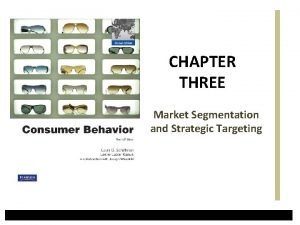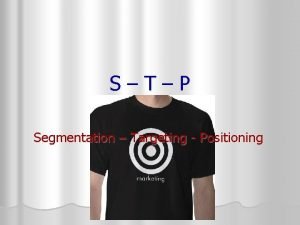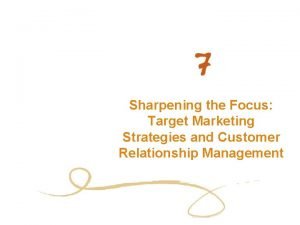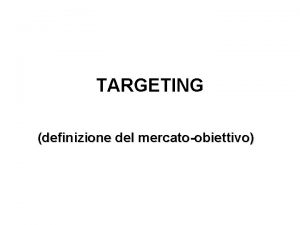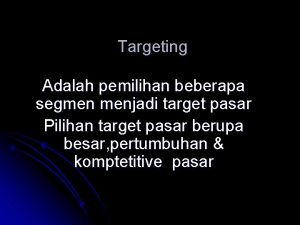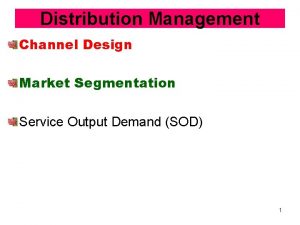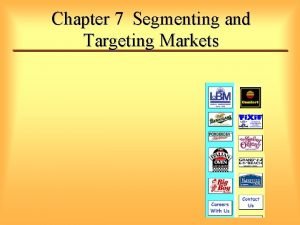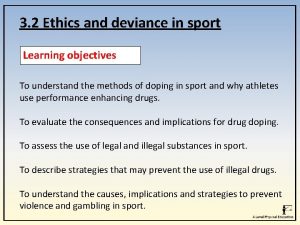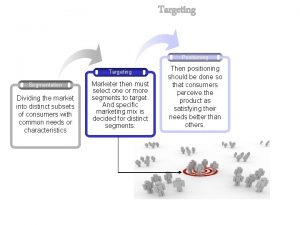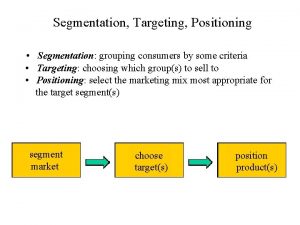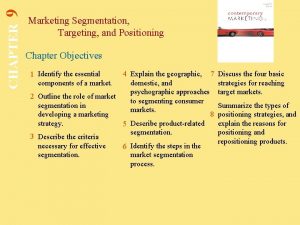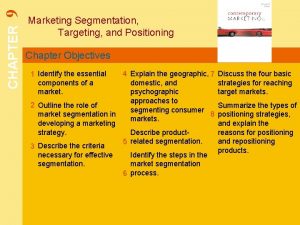Chapter 6 Segmentation Targeting and Positioning in Sport




















































































- Slides: 84

Chapter 6 Segmentation, Targeting, and Positioning in Sport Business

Segmentation • Segmentation is the division of a whole into parts. Putting things in order helps arrange them so that we can make sense of them. • The division of a consumer market into relatively homogeneous segments is sport consumer market segmentation. • The division of the sport industry into relatively homogeneous segments is sport industry segmentation. • Segmentation of the consumer market allows sport businesses to understand target specific groups that share characteristics and behaviors.

Segmentation (cont’d)

Segmentation (cont’d) Industry analysis and segmentation can reveal how a company compares to the competition or determine if it can compete in a particular segment. This allows the company to concentrate its efforts on particular segments and thus use its resources most efficiently.

Purposes of Segmentation • The primary purpose of market segmentation is specialization. • Targeting specific populations is the future of marketing in sport business. • The sport industry is growing to meet new consumer needs and to provide new support and services.

Important Market Segmentation Criteria Identifiability: segments must be identifiable and measurable. Substantiality: segments must be of a size large enough to justify marketing mix attention. Accessibility: segments must be reachable with the customized marketing mix. Responsiveness: segments must respond to a marketing mix customized to that segment.

Bases for Segmentation The object of market segmentation is to develop useful data about a particular group. Segmentation using one base selects members from a group that share a particular characteristic, while multiple base segmentation selects for a variety of characteristics. The latter method is increasingly popular as the culture becomes more multi-faceted.

Bases for Segmentation (cont’d)

Demographic Segmentation Typical Demographics: • Age • Gender • Household status • Income: individual or household • Occupation • Education • Race • Nationality • Social class • Religion

Psychographic Segmentation Demographic information is a good start in describing and developing segmentation strategies, but demographics don’t paint the full picture. Personality characteristics, favorite color, motivation factors, desires, attitude, and beliefs are some of the many other types of information that describe and define a person. These are called psychographics. Some psychological factors used: Personality Physiological Psychological Lifestyle Desire for Freedom from

Maslow’s Hierarchy of Needs (1954) • Self-actualization Needs self-fulfillment, self-expression • Esteem Needs self-esteem, self-respect, recognition • Social Needs love, appreciation, fun, belonging • Safety Needs security, freedom from pain • Physiological Needs food, water, shelter

A Typical Consumer Decision-Making Process All are affected and influenced by personal and social factors. – Step 1—Problem Recognition – Step 2—Information Search – Step 3—Evaluation of Alternatives – Step 4—Purchase – Step 5—Postpurchase Behavior

Compilation of factors that affect attendance Consumers who already know about or have experience with a product require a salesperson who can speak knowledgeably about the product and answer more detailed questions.

Product Use and Benefits Segmentation A Customer Needs: a product in order to satisfy a need or desire. Therefore, the product is the tool for the consumer to perform certain functions and realize certain benefits.

Business Consumer Segmentation n n Sport Business Consumers Manufacturers Resellers Sports Governing Bodies Institutions Media Sports Enterprises

Bases for Business Consumer & Industry Segmentation Business: • Geographic location • Customer type • Customer size • Product use • Purchase criteria Industry:

A Typical Segmentation Process Step 1—Select a market or industry Step 2—Select one or more segmentation bases Step 3—Select specific variables Step 4—Analyze the segment Step 5—Select one or more target markets Step 6—Develop appropriate marketing mix strategies When segments are very similar to each other, an undifferentiated targeting strategy—much like mass marketing— may be used, whereby all consumers receive the same marketing treatment.

Positioning the Sport Business Positioning establishes the image of a product or company and becomes the consumer’s base of reference when deciding which company’s product to purchase.

A Simple Positioning Process n Step 1—Identify the target market’s product attribute preferences n Step 2—Identify current positioning strategy n Step 3—Analyze current position and the market’s preferred product attributes n Step 4—Determine a positioning strategy

Chapter 6 Questions 1. Describe how the population of your country has changed over the last 25 years and how it is going to change in the next 25 years. How will this affect the sport business industry? 2. What types of marketing strategies are sport businesses using more often for emerging markets? Describe each one and how they work. 3. What are segmentation, sport consumer market segmentation, and sport industry segmentation?

Chapter 6 Questions (cont’d) 4. What are bases for segmentation? Describe how they are used. 5. What is target marketing? Describe how to determine or more target markets for a sport business. 6. What is positioning? Describe how to develop a positioning strategy for a product and a consumer market.

Learning Activities 1. Using students in your class, conduct a study of demographics, psychographics, and other segmentation bases and variables using sporting goods as a basis. What did you learn about the class? How could this information be used if your company is a sporting goods retail company?

Learning Activities (cont’d) 2. Write down a sports product that you purchased recently, one that is sold by more than one company. Create two columns, one labeled “My Buy” and the other “Didn’t Buy. ” In the “My Buy” column, create a list of all of the reasons you bought the product. In the “Didn’t Buy” column, list of all of the reasons you didn’t buy the product from other companies. On another sheet, list all the information that helped you decide on your purchase (family, friends, advertising).

Learning Activities (cont’d) 2. (cont. ) Write down all the things the people told you or that you remember from the advertising. Now compare all your notes and see if there is a relationship between any of them. Why do you think you found a relationship between, for example, the reasons you bought the product from a specific company and the company’s advertising for that product?

Learning Activities (cont’d) 3. With a group, determine a way to segment the sport industry. First, determine a reason for segmenting the industry, such as pretending that your group is a television broadcasting company that focuses on extreme sports events. Develop bases for segmentation. Determine an appropriate marketing mix strategy for your company.

Learning Activities (cont’d) 4. Pretend that your company is a team of the WNBA. You want to increase spectator attendance numbers for each game, but you also want to increase the number of games that many of your fans attend during a season. Develop a list of the factors that have an influence on attendance and design a study that will answer the questions you have for your fans.

Learning Activities (cont’d) 5. Identify some different sport businesses such as a manufacturer and a sport facility. Identify different consumer markets for the products. Develop positioning statements for each consumer market.

Chapter 7 Marketing Information Systems

Marketing Information Systems (MIS) • Marketing information systems—known as MIS, CIS, and IAM—deal with large amounts of information and are essential to the success of your sport organization or company. • MIS allows companies to establish channels of communication in order to maintain a relationship with consumers. These relationships allow marketers to increase consumer loyalty and thus encourage repeat purchases.

Obtaining Information n The most popular methods for primary data collection for sports organizations are direct-mail surveys, telephone interviews, and personal interviews. n The three models of consumer loyalty programs are the points and prizes model, the plateaus, perks, and prizes model, and the membership program model.

Designing Information Systems

Designing Information Systems (cont’d) Mullin (1985) and Grantham’s, Patton, York, and Winick’s (1998) essential characteristics of an effective sport marketing database: 1. A protocol must be established. 2. It must be linked to a central processing unit. 3. Storage capacity must be planned into the system. 4. Various databases need to be fully integrated. 5. The data must be retrievable in a form that the sport marketer can use. 6. Control mechanisms should be designed into the system to facilitate data security.

Maintaining Data Security Watch for two potential security problems with using microcomputers to help manage data—the erasure of a disk’s content upon exposure to magnets or general disk failure and the availability of data to unqualified people.

Getting the System to Work Two common mistakes often made in the application of computers in sport organizations: 1. Managers buy a computer with the idea that a job will be found for it to do. 2. The people who will be using the computer are often not involved in the testing and purchase of the system.

Getting the System to Work (cont’d) • Two basic types of programs are available, custom programs and commercial “off-the shelf” business applications. • In the event that your organization has special needs, you may need to have a software program written especially for your applications. • Many commercial programs have companion software that will allow you to create and move information from one application to another.

Working with the System MIS cannot be expected to solve problems efficiently as soon as the computer comes out of the box. According to Shaw (1991), an MIS must be designed “with a view to the people who will use them, and with an understanding of how the business in which they work operates. [An MIS] must deliver the right information to the right people at the right time” (p. 60).

Producing Results The main goal of conducting marketing research and analyzing data is to determine who will buy what goods and when.

Chapter 7 Questions 1. What are the essential characteristics of a well-designed marketing information system? 2. What MIS sources would be available for an intercollegiate athletic program, and how would you go about setting up an MIS?

Learning Activities 1. Select your favorite sport and consult a copy of Simmons Market Research Bureau. See where you fit in the demographic segments presented. 2. Take a trip to your local fitness center or health club, and inquire about the types of information they have on their clients. Also look at their application form if they are uncooperative with your first request.

Chapter 8 The Marketing Mix and the Sport Industry

The Marketing Mix: the strategic combination of product, price, place, and promotion decisions and strategies. Creation of the marketing mix involves the process of discovering or developing the right combination of product, price, place, and promotion.

Marketing Mix Elements The 4 Ps n Product n Price n Place n Promotion

Marketing Mix Elements (cont’d) If the consumer believes that a product is overpriced or even underpriced, there is a good chance that the consumer will not purchase the product.

Marketing Mix Elements (cont’d) n. Though the public is often under the impression that promotion is strictly advertising, it is actually a process—the goal is to create enough interest in a product to convince a consumer to purchase it. n. Research is the foundation upon which all marketing decisions are made.

The Interrelationship of the Elements Consumer purchases are not arbitrary—the consumer is looking for a product that satisfies a need or desire. n From that perspective, the product and everything about the product take on characteristics beyond the intended function of the product. This notion must be understood by the sport businessperson and used during the development of a marketing mix. n

The Marketing Mix Strategy in the Sport Industry • As the sport marketer identifies consumer market segments and selects target markets, the marketing mix elements are designed specifically for the consumer. • Also affecting the decision to open a fitness center is information concerning the industry and the competition. • In addition, the marketing mix should change as markets change. • The information gained from research should be current. Therefore, research should be an ongoing process within the company.

Chapter 9 The Product in the Sport Industry

Product Defined n Product: should be understood as a concept and must be used as an umbrella term that includes goods, services, people, places, and ideas with tangible or intangible attributes. n A tangible product is a concrete, physical object while an intangible product is indefinite. To buy a baseball is to receive a tangible product; to attend a baseball game is to receive an intangible product.

Four Types of Utility A product’s utility is its ability to satisfy a consumer’s need. Four aspects of this include Form—using raw materials to produce a product n Time—making a product available when the n consumer wants it n Place—getting the product to the venues where the consumer shops n Ownership—transferring ownership or possession of a product from seller to buyer

Sport Product Defined n Sport product: any good, service, person, place, or idea with tangible or intangible attributes that satisfy consumer sport, fitness, or recreation related needs or desires.

Sport Product Classifications A product category is a group of products that are either exactly alike or have homogeneous characteristics. Studying these categories enables marketers to fully understand market their product. Consumer products are those products offered to the final consumer for personal or household use. Business products are those products offered to businesses or organizations for use in the production of other goods and services, to operate a business, or for resale to other consumers.

Sport Product Classifications (cont’d) • A rented-goods service is the renting of a product for a period of time. • Owned-goods services include those services to repair or alter something that the consumer owns. • Nongoods services do not involve a good at all. This category includes personal services offered by the seller. • Business products in the sport industry are those products offered to sport businesses for use in the manufacture of sport products, to operate a sport business or for resale.

Industry Segmentation n Industry segmentation is the division of an industry into industry segments in order to develop a competitive strategy. The sport industry can be divided into the sport performance segment, the sport production segment, and the sport promotion segment.

Industry Segmentation (cont’d)

The Sport Product Life Cycle Studying, understanding, and managing products and their life cycle stages can have considerable influence on the success of a company. n Through research, it is now known that (a) product lives are shorter now than in the past; (b) higher investment is now required for new products; (c) the marketer may use the product life cycle to adjust marketing strategies; and (d) the marketer may strategically establish a more successful product mix in relation to the product life cycle concept—planning to establish products in each stage of the cycle so that, as one product declines, another product is introduced. n

Stages of the Product Life Cycle

Stages of the Product Life Cycle n Product promotions stress information about a product, as well as its features and, perhaps most important, what it does for the consumer. n By the time a product reaches the maturity stage, all the companies producing it have most likely discovered the successful product, price, and other marketing strategies that keep the product selling.

The Product Mix and Product Management Product mix is the complete set of all products that the sport company offers to the consumer. n A product item is a specific product within a product line. n Product management involves deciding which products to offer, what type of a product line to carry, when to keep or delete a product, when to add new products, and other product management strategies. n

The Product Mix and Product Management (cont’d) n. A product’s position is the image or perception that the consumer holds about the product’s attributes, quality, uses and other functions as these compare to other similar products. n New product development as a strategy is the addition of a new product to a company’s product line.

The Product Mix and Product Management (cont’d) 3 Aspects of Product Mix n Width is the number of product lines offered. n Depth is the number of items within a line. n Consistency refers to the similarity of product lines.

Nine Ways to Offer a New Product 1. A product that performs an entirely new function. 2. A product that offers improved performance of an existing function. 3. A product that offers a new application of an existing one. 4. A product that offers additional functions over an existing product. 5. When an existing product is offered to a new consumer market. 6. Offering a lower cost on a product can attract new buyers. 7. A product offered as “upgraded” or an existing product integrated into another product. 8. A downgraded product or the use of less expensive parts or components in the manufacturing process. 9. A restyled product.

New Product Development Planning and Process

Stages in the New Product Development Process 1. The idea generation stage involves generating ideas for new products, product modification, or other types of product change ideas. 2. The next stage is product screening and analysis. This involves determining the feasibility of a product, if the company can market a product profitably, if the product fits with the company’s mission, if the company has all the necessary resources or technology, or if it might be beneficial to form partnerships with other companies. 3. In the product research and development stage, product ideas with potential are converted.

Product Identification The establishment of a brand—a name, symbol, term, or design that represents a product—is important because it allows the idea of a product to exist in a consumer’s mind even when the product itself isn’t visible. n Consumers react to branding on three levels: brand recognition, brand preference, and brand insistence. Companies aim for brand insistence, the level at which consumers will buy only their brand no other. n

Product Identification (cont’d) n It is important to remember that sport event packaging includes not only the product or services themselves, but also certain elements of presentation such as the cleanliness of facilities, the attitude of the staff, and the amount of attention paid to the consumer during the event.

Product Deletion n For most products, the time will arrive when it no longer is fulfilling a need or desire for a consumer. The sport marketer must be able to identify that time and make the decision to eliminate the product. The decision should be based on an analysis of the product’s situation: sales and sales trends, profits trends, cost analysis, and product life cycle stage.

Chapter 9 Questions 1. What is a product? What is a sport product? List examples of sport products. 2. Why do people purchase sport products? 3. Define these terms: form utility, time utility, place utility, and ownership utility. Give an example of each. 4. What is product classification?

Chapter 9 Questions (cont’d) 5. What is the product life cycle? What are the stages in the product life cycle? 6. Give examples of sport products in each product life cycle. 7. Why is it important for the sport marketer to know in which stage of the product life cycle each of the sport company’s products may be categorized?

Chapter 9 Questions (cont’d) 8. What is the product mix? Why is it important? 9. How many ways might a sport company offer a new product? 10. What is the new product development planning process? What are the stages? 11. What is product identification? Why is it important? How is it used in the sport industry?

Learning Activities 1. Using the definition of sport product in this chapter, create a list of 10 sport products for each of the categories: goods, services, people, places, and ideas. 2. Using the Pitts, Fielding, and Miller Sport Industry Segmentation segments, list products offered to consumers and business consumers in your city or community. 3. Determine in which stage each of the products you listed in number 2 fall onto the product lifecycle.

Learning Activities (cont’d) 4. Interview some of the sport businesses, organizations, or other enterprises in your city or community and ask about new product development and new product research and development. 5. Conduct a class study of product identification. Show company brand names or logos on overhead transparencies and ask students to try to identify each. 6. To study how today’s sports events are packaged, attend a small sporting event and a large sporting event. Take a notebook. Make a list of everything involved and surrounded the events: parking, preevents (such as, pre-game shows), and other activities and services offered.

Chapter 10 Pricing Strategies for the Sport Industry

Price n Price is the exchange value of a good or service. It fluctuates according to its exchange value in the marketplace, or its market value. n Value is the quantitative measure of the worth of a product. n Perceived value is what the consumer thinks something is worth.

The Four Cs of Price Determination Consumer n the Competitor n the Company n the Climate (environment) n the

Developing an Effective Pricing Strategy

Elasticity of Demand Elasticity is a measure of how consumers react—consumer sensitivity—to changes in price. The following questions can help you understand this concept: 1. What will happen if we raise the price of a sport product? If fewer consumers purchase the product, how many is “fewer”? How will that affect revenue, profit, and sales? 2. What will happen if we decrease prices? Will more consumers purchase the products? How will this affect revenue, profit, and sales? 3. Is there any guarantee that any change in price will result in a change in consumer purchase pattern?

Elasticity of Demand— Relatively Inelastic

Elasticity of Demand— Relatively Elastic

Some Factors That Effect Elasticity of Demand n n n n n product necessity or luxury product substitute availability frequency of purchase proportion of income available for a specific product economy brand loyalty competition (quantity and quality) quality of the product specialization time frame of demand

Pricing Objectives for the Sport Business The 4 Cs Consumer • price sensitivity • purchase decision • fairness • image • maximize opportunity • targeted markets Climate • legal restraints • sensitivity Competition • meet competitive prices • be price leader • stabilize the market • discourage entrants to the market Company • image • cost • efficient use • return on investment • profit margin • increase market share • survival • growth

Pricing Methods and Strategies for the Sport Business Going-rate pricing (also called status quo pricing) Demand-oriented pricing Price discrimination Peak-load and off-load pricing Seasonal pricing Average cost pricing Penetration pricing Cost-plus pricing Break-even analysis Short-term pricing methods Product line pricing Single price Secondary market pricing

Short-term Pricing Methods n Quantity discounts (the more you buy, the lower the price per unit) n Special sales n Allowances n Rebates n Clearance sales n Promotional sales

Chapter 10 Questions 1. How does the consumer perceive “price”? 2. Discuss the concept of price. 3. List some examples of words used in place of the word price that can be found in the sport industry. Explain why these words are used. 4. What are the 4 Cs of price consideration? Discuss each and give examples. 5. Discuss the concept of the elasticity of demand. 6. List some examples of pricing objectives for sport. 7. List and describe some pricing strategies for the sport industry.

Learning Activities 1. Identify sport businesses, organizations, or other enterprises and their products in your city or community that use these pricing strategies: going-rate pricing, demand-oriented pricing, price discrimination, seasonal pricing, shortterm pricing, and product line pricing. 2. Identify in your city or community some of the sport businesses, organizations, or other enterprises that use the price titles as presented in this chapter such as licensing fee, admission, and purse.
 Global consumer culture positioning example
Global consumer culture positioning example Avon market segmentation
Avon market segmentation Sony market segmentation, targeting and positioning
Sony market segmentation, targeting and positioning Positioning involves meeting consumers lower performance
Positioning involves meeting consumers lower performance Chosen lesson 7 segment 1
Chosen lesson 7 segment 1 Nokia target market
Nokia target market Nivea market segmentation
Nivea market segmentation Market segmentation examples in pakistan
Market segmentation examples in pakistan Segmentation targeting positioning analysis
Segmentation targeting positioning analysis Market segmentation, targeting and positioning
Market segmentation, targeting and positioning Segmentation targeting and positioning of colgate
Segmentation targeting and positioning of colgate Benefits of market segmentation targeting and positioning
Benefits of market segmentation targeting and positioning Segmentation
Segmentation Concentrated marketing
Concentrated marketing Undifferentiated products examples
Undifferentiated products examples Global market segmentation
Global market segmentation Global segmentation and positioning
Global segmentation and positioning Market segmentation and targeting ppt
Market segmentation and targeting ppt Marketing segmentation targeting positioning
Marketing segmentation targeting positioning Segmentation bases
Segmentation bases Customer segmentation targeting
Customer segmentation targeting Physician segmentation and targeting
Physician segmentation and targeting Positioning in rural marketing
Positioning in rural marketing Consumer rooted segmentation bases
Consumer rooted segmentation bases Strategie positioningu
Strategie positioningu Stp marketing
Stp marketing Segmentace targeting positioning
Segmentace targeting positioning Jurnal internasional segmenting, targeting, positioning
Jurnal internasional segmenting, targeting, positioning Sport england market segmentation
Sport england market segmentation Positioning transfers and ambulation
Positioning transfers and ambulation Positioning moving and lifting
Positioning moving and lifting Bullseye positioning model
Bullseye positioning model Joint targeting cycle
Joint targeting cycle Mktg 8
Mktg 8 Concentrated marketing
Concentrated marketing Polygon targeting
Polygon targeting Designing a customer driven marketing strategy
Designing a customer driven marketing strategy Undifferentiated targeting strategy
Undifferentiated targeting strategy Concentrated targeting
Concentrated targeting Alcohol commercials targeting youth
Alcohol commercials targeting youth Gdn targeting options
Gdn targeting options Target marketing
Target marketing Protein targeting pathways
Protein targeting pathways Marketing concentrato
Marketing concentrato Targeting adalah
Targeting adalah Targeting v marketingu
Targeting v marketingu Definisi targeting
Definisi targeting Cross vertical industry
Cross vertical industry Connection targeting
Connection targeting Find-fix-finish-exploit-analyze targeting model
Find-fix-finish-exploit-analyze targeting model Positioning and staffing the security function
Positioning and staffing the security function Charles and keith shoe
Charles and keith shoe Bluetooth positioning using rssi and triangulation methods
Bluetooth positioning using rssi and triangulation methods Positioning and draping
Positioning and draping General physical examination
General physical examination Digestive system
Digestive system Peristalsis and segmentation
Peristalsis and segmentation Peristalsis and segmentation
Peristalsis and segmentation In segmentation each address is specified by
In segmentation each address is specified by Difference between peristalsis and segmentation
Difference between peristalsis and segmentation Insight segmentation and registration toolkit
Insight segmentation and registration toolkit Pros and cons of geographic segmentation
Pros and cons of geographic segmentation Family life cycle stages
Family life cycle stages Market segmentation and service output demand
Market segmentation and service output demand Task state segment
Task state segment Market segmentation geographic demographic psychographic
Market segmentation geographic demographic psychographic Clartas
Clartas The relationship between sport sponsorship and media
The relationship between sport sponsorship and media What does naf mean in sport
What does naf mean in sport Ocr level 3 sport
Ocr level 3 sport How do you find these activities
How do you find these activities Deviance in sport
Deviance in sport Physiology of sport and exercise 5th edition
Physiology of sport and exercise 5th edition Sports exercise and health science ib
Sports exercise and health science ib Ib sport exercise and health science
Ib sport exercise and health science Physical activity and sport pedagogy definition
Physical activity and sport pedagogy definition Exercise psychology definition
Exercise psychology definition Department of sport and recreation wa
Department of sport and recreation wa Relationship between sport and politics
Relationship between sport and politics Culture and sport glasgow
Culture and sport glasgow Mpumalanga department of culture sport and recreation
Mpumalanga department of culture sport and recreation What has roads but no cars rivers but no water
What has roads but no cars rivers but no water Sport management principles and applications
Sport management principles and applications Sport and the mass media guided reading
Sport and the mass media guided reading Fitness testing for sport and exercise
Fitness testing for sport and exercise























